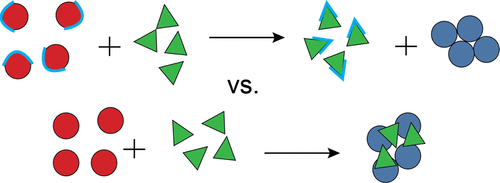Our official English website, www.x-mol.net, welcomes your
feedback! (Note: you will need to create a separate account there.)
Effects of Cationic Proteins on Gold Nanoparticle/Aptamer Assays.
ACS Omega ( IF 3.7 ) Pub Date : 2017-11-20 , DOI: 10.1021/acsomega.7b01336 Thomas A Pires 1 , Conor M Narovec 1 , Rebecca J Whelan 1
ACS Omega ( IF 3.7 ) Pub Date : 2017-11-20 , DOI: 10.1021/acsomega.7b01336 Thomas A Pires 1 , Conor M Narovec 1 , Rebecca J Whelan 1
Affiliation

|
Gold nanoparticles (AuNPs) and aptamers are compelling building blocks for analytical assays with desired attributes of selectivity and sensitivity and may theoretically form the basis of instrument-free color-changing assays for any target against which a DNA aptamer has been selected. However, assays for proteins based on these components may be subject to significant interferences from the interaction of proteins with nanoparticles. We found that for three representative protein/aptamer systems-thrombin, apolipoprotein E, and platelet-derived growth factor-pH-dependent aggregation occurred, even in the absence of the aptamer, to differing extents. This effect is most pronounced when proteins display net surface charge (i.e., when pH < pI) but can even be observed at pH = pI when the protein retains regions of positive charge. These interactions of AuNPs and cationic regions on proteins may present an important limitation on the development of AuNP-based analytical assays.
中文翻译:

阳离子蛋白对金纳米颗粒/适体测定的影响。
金纳米粒子(AuNPs)和适体是具有理想的选择性和灵敏度属性的分析测定的引人注目的构建基块,并且在理论上可构成针对已针对其选择DNA适体的任何靶标进行无仪器变色测定的基础。但是,基于这些成分的蛋白质分析可能会受到蛋白质与纳米颗粒相互作用的重大干扰。我们发现,对于三种代表性的蛋白质/适体系统,即使在没有适体的情况下,也会发生凝血酶,载脂蛋白E和血小板衍生的生长因子-pH依赖的聚集。当蛋白质显示出净表面电荷时(即,pH <pI时),这种作用最为明显,但当蛋白质保留正电荷区域时,甚至在pH = pI时也可以观察到。
更新日期:2017-11-20
中文翻译:

阳离子蛋白对金纳米颗粒/适体测定的影响。
金纳米粒子(AuNPs)和适体是具有理想的选择性和灵敏度属性的分析测定的引人注目的构建基块,并且在理论上可构成针对已针对其选择DNA适体的任何靶标进行无仪器变色测定的基础。但是,基于这些成分的蛋白质分析可能会受到蛋白质与纳米颗粒相互作用的重大干扰。我们发现,对于三种代表性的蛋白质/适体系统,即使在没有适体的情况下,也会发生凝血酶,载脂蛋白E和血小板衍生的生长因子-pH依赖的聚集。当蛋白质显示出净表面电荷时(即,pH <pI时),这种作用最为明显,但当蛋白质保留正电荷区域时,甚至在pH = pI时也可以观察到。











































 京公网安备 11010802027423号
京公网安备 11010802027423号